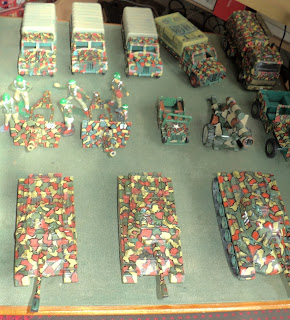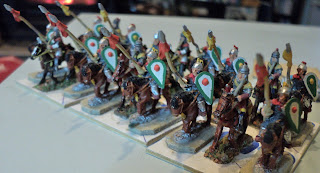 |
| The opening battle of the late Barry Taylor's 'Wartenburg' Campaign. |
This posting is somewhat inspired by recent discussions in David Crook's blog spot, A War gaming Odyssey. This article has lain in draft form for overlong, but I'll publish it here anyhow, with odd pictures added. Many of those long-time readers might recognise. Mr Crook observed that the 18th Century lends itself so well to Imagi-Nations, and the creation of fictitious armies, with perhaps an exercise in developing one's own uniform (not to mention flag) designs. Why not other periods? My own view is that the 19th and 20th are both susceptible to such treatment.
 |
| Ulrichstein Campaign: Electoral forces attacking Ulrichstein rebels at Zaltpig. |
I will admit at the outset, though, that my 18th century armies, though fictitious, are very much based upon historical prototypes. The Empire, its capital at Schnitzel, is a rather more coherent form of the Hapsburg Empire, The Emperor Violoncello modelled a little on Charles V, and the Empress Harmonica is a thinly disguised Maria Theresa. The characters of the originals have been modified for my own narrative. The great and good Archduke Piccolo, the Emperor's nephew (and hence the Empress's cousin) though not what you'd call a rash commander, is no Leopold von Daun. Altmark-Uberheim is a rather more piratical "Prussia", The Grand Duchy of M'yasma a kind of Russia en petit, and Ursaminor (whose army uniforms I did design) a very vague form of Sweden - the bit on the south Baltic coast.
 |
| Ulrichstein Campaign: Imperial Army, under the Archduke Piccolo himself, advancing into battle against the main Ulrichstein rebel army. |
For some reason, I've never been able to face the prospect of creating an Imagi-Nations form of the Napoleonic wars, though fictitious campaigns and wars do hold an attraction. My method there is to tweak history a bit. For instance, in the 1809 war, the Battle of Znaym may have been fought to an indecisive conclusion. With Austria still in the fight, suddenly the British found the means to drop a considerable force under General Sir Arthur Whitbread onto southern Italy, where it was to be joined by a cobbled together force of two Austrian Army Corps under Count Eusebius von Carlsberg. The local French Commander, General Dubonnet (in line for the Marshalate) had, however, a considerable force in the region with which to try and hold the Mainland portion of the Neapolitan Kingdom.
 |
| Ulrichstein Campaign: closing stages of the battle that broke the rebellion. |
Or one might simply redesign the other campaigns according to what troops one has available. I will probably be returning to this topic in future blog postings.
The renaissance period suggests a small war between the Austerian Empire and the Severian Kingdom. Of course, one might easily discern behind the names, Austria and Sweden (Sverige). and the similarity of meaning between 'austere' and 'severe' lends a certain ... wit, shall we suggest? ... to the proceeding.
The renaissance period suggests a small war between the Austerian Empire and the Severian Kingdom. Of course, one might easily discern behind the names, Austria and Sweden (Sverige). and the similarity of meaning between 'austere' and 'severe' lends a certain ... wit, shall we suggest? ... to the proceeding.
 |
| 30YW - fought between the armies of Imperial Austeria and Royal Severia. |
The mediaeval period has suggested to me the Wars of the Clover (White Clover vs Pink), for which I already have the figures, but they are wanting their paint; and perhaps 4-5 centuries earlier, the beleaguered Ionian Empire holding out against surrounding Barbaric pressure.
My own Imagi-Nations 19th century project was originally inspired by H.G. Wells's 'Little Wars' but was intended for a Colonial setting rather like Joe Morchauser's Hausserian Wars. The respective RED (Ruberian) and BLUE (Azurian) forces represented a Brigade group: 3 battalions, with a squadron of cavalry and a gun battery attached. Some vague notion that a GREY (Grauheim) or GREEN (Gruenheim) might join them in disputatious claims to a sizable and lush territory of Mweusiland. The Mweusi (BLACK) are a warrior people who take rather a dim view of being colonised.
I even had a map of the region drawn up, based upon the back yard of the house I was then living in. But this project was largely modified into a straightforward one-on-one struggle over chronic border disputes and violations between the RED and BLUE nations. GREY (Grauheim) and PURPLE (Porphyria) are hidden Allies whose navies are likely to be involved, but whose land forces tend to be directed away from intervening in the Ruberian-Azurian conflict.
 |
| Kiivar 'Armoured' Infantry |
It was a visitor the Woolston Club 4 years ago who alerted me to the possibilities presented by Twentieth Century style conflicts and Army Men. Actually, it has been a bit more complicated than that. An article in Model Soldier 30-odd years ago suggested the idea of small wars in Latin America (or Africa, or the Middle East, whence comes to that) using a hotch-potch of surplus WW2 equipments, picked up for a song by belligerent but somewhat impecunious small states. The ambitious and acquisitive state of Orotina, under its dictator President Adolfo Ximinez, has acquired by mysterious means, a large inventory of German WW2 equipment, even unto a company of Tiger II and JagdTigers. Vastly outnumbering the neighbouring states, Pan-Andean People's Republic and Gran Bolivaria, Orotina plans to expand its territories at the expense of both. But the sources of replacements are running out for Orotina, whereas its opponents can count on replenishment from their respective sponsors, The Soviet Union, and Great Britain...
 |
| Raesharn equipment in their distinctive camo livery. |
Brian O'Sullivan, of A Fistful of Plastic fame (?), notoriety (?) Began years ago his Harad project - a vaguely 1980s Middle East conflict in which the Harad Empire, beset by external and internal political strife, is rapidly declining. A couple of years back, I was persuaded complicate Harad's situation in the form of the Nabob of Tchagai, lurking on Harad's eastern border awaiting the chance to grab for himself a slice of Imperial territory. Less well endowed with exploitable natural resources than the Haradian Empire, Tchagai can less afford to spend money on the latest generation of equipments, and with a small core of Leopard I and Vickers MBT Vs, has to bulk out its armour with WW2 vintage Sherman tanks.
But the Army Men project, though Jono decided the War Gaming aspect was less agreeable to him that creating imaginary worlds (for which he has a remarkably far-seeing talent), still continues as a solo project. Over the last couple of years I have acquired or been given or scratch built enough equipments to work on, and just need to organise and paint up a whole lot of troops. The savage battles between Kiivar and Raesharn I hope to revive later this year.
























































